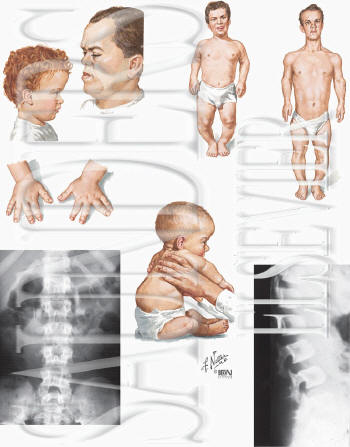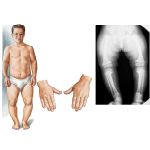


European Journal of
Radiology
www.achondroplasia.co.uk/
What is Achondroplasia?
Bulky forehead, saddle nose, lumbar lordosis, bowlegs
Very common today
Autosomal dominant
The iliac wings are short and squared off
Narrowing of the spinal canal
Achondroplasia is one of the most common causes of short stature today. People with Achondroplasia have an average body size but disproportionate (shorter) limbs. The average height of a male is 4'4" and a female is 4'1". This is due to the long bones growing more slowly as opposed to the rest of the body, both in the womb and throughout childhood. Young children with Achondroplasia may have hearing, speech or breathing problems, but all of these are treatable.
Most problems begin during the ossification process in the skeletal precursors of the foetus. There are two different methods of ossification that take place in the body:
Intramembranous Ossification: the bone formation of the skull, face and clavicle
Intracartilaginous Ossification: the formation of the remaining bones.
The skull, face and clavicle are all normal in achondroplasia because the first method is completed normally, but the second method is defective. This results in the retardation of the ossification of the remainder of the skeleton.
Achondroplasia in the Palaeopathological Record
Achondroplasia is rare in the palaeopathological record, however many types of dwarfisms are described in clinical literature. There have been five skeletons, dating from the prehistoric to the post-Medieval periods in Britain, that have been diagnosed with either proportionate or disproportionate dwarfism. Also, pictorial sources serve as evidence for the antiquity of Achondroplasia. Phtha, an Egyptian God, was given a dwarf status, showing the power and recognition of Achondroplasia in ancient societies.
Even though rare, there is skeletal evidence showing that there was Achondroplasia in the Old and New World. The first Old World skeletal remains are from the late Upper Paleolithic era located in Italy. Other skeletal evidence was found in pre-Dynastic Egypt and Poland. From the New World, skeletal evidence was found at a prehistoric Indian site where relatively complete skeletons of an adult male and female were found.
What is Hypochondroplasia?

 http://www.netterimages.com
http://www.netterimages.com
Hypochondroplasia is a form of short-limbed dwarfism similar to Achondroplasia, but the features are milder. This condition affects the ossification, occurring mostly in the long bones of the arms and legs. The adult height for men with this condition ranges 4'6" to 5'5". The height range for adult women is 4'2" to 4'11".
Hypochondroplasia causes short arms and legs and broad, short hands and feet and also a large head, limited range of motion at the elbows, lordosis, and bowed legs. The differences between Achondroplasia and Hypochonroplasia is that these characteristics are less distinct than those seen with Achondroplasia and may not be present until early or middle childhood.